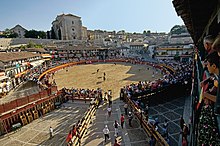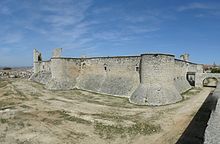Chinchón (Madrid)
| Chinchón parish | ||
|---|---|---|
 Chinchón - town view
|
||
| coat of arms | Map of Spain | |

|
|
|
| Basic data | ||
| Autonomous Community : |
|
|
| Comarca : | Las Vegas Comarca | |
| Coordinates | 40 ° 8 ′ N , 3 ° 25 ′ W | |
| Height : | 753 msnm | |
| Area : | 115.91 km² | |
| Residents : | 5,331 (Jan 1, 2019) | |
| Population density : | 45.99 inhabitants / km² | |
| Postal code : | 28370 | |
| Municipality number ( INE ): | 28052 | |
| administration | ||
| Website : | Chinchón | |
Chinchón is a small town and a municipality in central Spain ( municipio ) with 5,331 inhabitants (as of January 1, 2019) in the autonomous region of Madrid . The county of Chinchón is named after her. The old town center (Chinchón Viejo) was classified in 1974 as a cultural asset in the conjunto histórico-artístico category; the new district of Nuevo Chinchón is about 1.5 km to the west.
Location and climate
The small town of Chinchón is located in the southern part of the Castilian plateau ( meseta ) around 46 km (driving distance) southeast of Madrid at an altitude of around 750 m ; the cities of Aranjuez and Toledo are about 25 and 70 km southwest. The climate is harsh in winter, but temperate to warm in summer; Rain (approx. 415 mm / year) falls throughout the year with the exception of the summer months.
Population development
| year | 1857 | 1900 | 1950 | 2000 | 2017 |
| Residents | 4,605 | 5,074 | 4,880 | 4,168 | 5,331 |
Although Chinchón belongs to the greater Madrid area, the population of the municipality has changed only slightly since the middle of the 19th century.
economy
In the Middle Ages , Chinchón was a rural community that was large enough to serve as an artisanal and mercantile center (market) for the individual farms and small villages in the area. In the 19th century, fruit and wine brandies from Chinchón received awards at various trade fairs and exhibitions - including the two world expositions in Paris in 1889 and 1899. Nowadays, tourism in the listed old town center is an important source of income for the city .
history
There is no trace of the Celtiberians , Romans and Visigoths in the area around Chinchón. In Islamic times , the area was depopulated and was only after the reconquest ( reconquista ) Toledo by the troops of Alfonso VI. of León repopulated by Leon in 1085 ( repoblación ) . Chinchón has been a manor (señorio) since 1480 , which was secured by a castle. This was attacked in the Comuneros uprising (1520-1522) against the alien King Charles I and partially destroyed. In gratitude for loyal service in a difficult time, Charles I raised the area around Chinchón to a county and gave it to Fernando de Cabrera y Bobadilla as a hereditary fiefdom. First Diego Fernández de Cabrera y Mendoza , the 3rd Count of Chinchón, rebuilt the medieval castle in the late 16th century , but it was partially destroyed again in 1706 during the War of the Spanish Succession . In 1739 King Philip V gave the place the title "Villa Muy Noble y Muy Leal" ("extremely honorable and loyal place") in gratitude for the loyalty of its citizenship during the War of the Spanish Succession. This was associated with jurisdiction for the Counts of Chinchón. The brother of the then King Charles III. , the Infante Luis de Borbón y Farnesio , acquired the county of Chinchón in 1761. After the French invasion, four soldiers were killed in Chinchón in December 1808; then more troops were sent there, who besieged the city for three days and set several buildings on fire. A total of 86 people were killed in the uprising.
Attractions
- The main square of Chinchón with the balcony strips, galleries and facades typical of Castile is one of the most beautiful and largest Plazas Mayores in all of Spain. Today there are numerous restaurants and bars here. The square is still being converted into a bullring (plaza de toros) once a year .
- Not far from the square is the former Augustinian convent from the mid-18th century, whose brick- built cloister ( cloister with adjoining rooms) has been converted into a parador .
- The church of Nuestra Señora de la Asunción , built in the years 1534–1626 in a transition style from the late Gothic to the Renaissance , was badly damaged in the course of the Napoleonic Wars (1807–1814), but was restored around 1828. It is located above the north side of the Plaza Mayor and impresses with its unadorned exterior, which enhances the almost block-like monumentality of the building. The single-nave interior is enlarged by side chapels, in which there are altars with the associated retables . The main altar contains a painting by Goya depicting the Assumption of Mary .
- The basement of the 15th / 16th The clock tower (Torre de Reloj) , which was built in the 17th century and which belongs to the church of Nuestra Señora de Gracia , which was destroyed in 1808, is made entirely of stone, which also stabilizes the corners of the middle level; the upper floor, structured by pilaster strips, consists entirely of brick. The clock is an ingredient of the 19th century.
- The medieval-looking castle (Castillo de Chinchón) , built in the late 15th century, is located about 500 m south of the town center and - despite the slight hill on which it is located - is surrounded by a moat . The courtyard was only accessible via a drawbridge, above which a stone coat of arms with the family coat of arms of Diego Fernández de Cabrera y Mendozas almost completely covered the underlying cross of the Order of Santiago . The corners of the structure are occupied by round towers, which - like the steeply sloping embankments - served as flank protection.
Festivals
- The big festival in honor of the patron saint Nuestra Señora de Gracia y San Roque takes place from August 12th to 18th.
- Chinchón is best known in Spain for its Christ Passion (Pasión de Cristo) , which takes place every year on Holy Saturday . Around 250 people actively take part in the performance, which has an increasing number of viewers from year to year.
Web links
- Chinchón, historical buildings - photos + information (arteguias, Spanish)
- Chinchón, history - photo + information (French)
- Chinchón, sights - photos + quick facts (spanish)
Individual evidence
- ↑ Cifras oficiales de población resultantes de la revisión del Padrón municipal a 1 de enero . Population statistics from the Instituto Nacional de Estadística (population update).
- ↑ Chinchón - climate tables
- ^ Chinchón - population development
- ^ Chinchón story
- ^ Chinchón story
- ↑ Chinchón - Plaza Mayor
- ^ Chinchón - Augustinian convent
- ↑ Chinchón - Church of the Assumption
- ↑ Chinchón - clock tower
- ↑ Chinchón - Castillo






